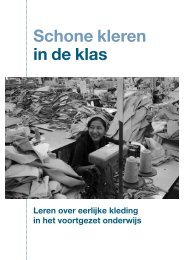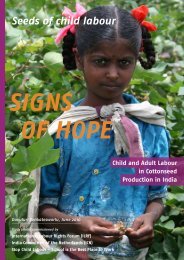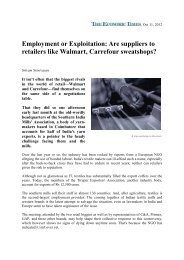Child Bondage Continues in Indian Cotton Supply Chain
Child Bondage Continues in Indian Cotton Supply Chain
Child Bondage Continues in Indian Cotton Supply Chain
You also want an ePaper? Increase the reach of your titles
YUMPU automatically turns print PDFs into web optimized ePapers that Google loves.
All the major seed companies have production facilities <strong>in</strong> Gujarat. The total area under<br />
cottonseed production <strong>in</strong> the state has marg<strong>in</strong>ally decl<strong>in</strong>ed from 26,000 acres <strong>in</strong> 2003-04 to<br />
25,400 acres <strong>in</strong> 2006-07. Out of 25,400 acres <strong>in</strong> 2006-07, 24% of the area (6000 acres) was<br />
under the control of a s<strong>in</strong>gle <strong>Indian</strong> based company called Nuziveedu seeds. The other<br />
important companies with production bases <strong>in</strong> Gujarat are Ankur (5000 acres), Vikram (2000<br />
acres), Nath (2000 acres), Mahyco (1500 acres) and Vibha (800 acres).<br />
The extent of the area us<strong>in</strong>g illegal official BT cotton is significant <strong>in</strong> Gujarat. Before the<br />
government of India approved the commercial release of BT cotton hybrids, a private seed<br />
company based <strong>in</strong> Gujarat developed local BT cotton hybrids through back cross<strong>in</strong>g the BT<br />
gene with local hybrids and unofficially started market<strong>in</strong>g the seeds s<strong>in</strong>ce the BT cotton<br />
hybrids of Mahyco Monsanto Bio Tech Limited (MMB) were costly (450 grams of packet seeds<br />
were sold for Rs 1600 until 2005-06). After the <strong>in</strong>tervention of the central and state<br />
governments, MMB reduced the price of a 450 gram seed packet to Rs. 750 <strong>in</strong> 2006-2007.<br />
This encouraged many small companies, <strong>in</strong>clud<strong>in</strong>g some <strong>in</strong>dividual farmers, to enter <strong>in</strong>to the<br />
production of illegal BT cotton hybrid seeds which led to a significant <strong>in</strong>crease <strong>in</strong> the area<br />
under production of these seeds <strong>in</strong> the early 2000s. However, the area under illegal BT cotton<br />
hybrid seed production came down significantly after MMB reduced the price <strong>in</strong> 2006-07. In<br />
2003-04, nearly 10,000 acres was under illegal BT cottonseed production <strong>in</strong> the state which<br />
has come down to 4000 to 5000 acres <strong>in</strong> 2006-07.<br />
An important feature of cottonseed production <strong>in</strong> Gujarat state is that more than two thirds of<br />
the labour force engaged <strong>in</strong> cottonseed production is seasonal migrant labour (adults as well<br />
children) belong<strong>in</strong>g to Scheduled Tribe (ST) communities com<strong>in</strong>g from the southern part of<br />
Rajasthan (Dungapur, Udaypur and Khervad) and tribal pockets of Gujarat (Panchamahal,<br />
Sabarkantha and Santrapur). More than 50% of the migrant labourers are from Udaypur and<br />
Dungapur districts <strong>in</strong> Rajasthan. These two districts are perennially drought prone areas and<br />
are known for large-scale out migration of labourers to other areas <strong>in</strong> search of wage work.<br />
The recruitment of migrant child and adult workers for work <strong>in</strong> cotton fields of North Gujarat<br />
is dependent upon an extensive network of agents, locally called ‘mates’, <strong>in</strong> the tribal villages<br />
(Katiar 2006). The mates are local tribal villagers who have had an exposure to the<br />
cottonseed work. Before the season starts, seed farmers approach these mates, place their<br />
demand for labourers, and pay some advance money The advance money <strong>in</strong>cludes travel<br />
costs of the labourers from their home to work and some advance equivalent to one or two<br />
weeks worth of wage payment. The per day wage rates are fixed <strong>in</strong> advance and the<br />
agreement lasts for one crop season (three months). It is the responsibility of the mates to<br />
identify the required number of labourers and see to it that they cont<strong>in</strong>uously work for the<br />
farmer for the entire agreement period. Each mate mobilises around 20 to 100 labourers and<br />
places them with different farmers. Farmers do not make any <strong>in</strong>dividual agreements with the<br />
labourers and <strong>in</strong>stead they only <strong>in</strong>teract with mates, who <strong>in</strong> turn make agreements on behalf<br />
of the labourers. F<strong>in</strong>al payments are settled at the end of the season. In the middle of the<br />
season, small amounts of money are given to the workers for their liv<strong>in</strong>g expenses. The mates<br />
30







